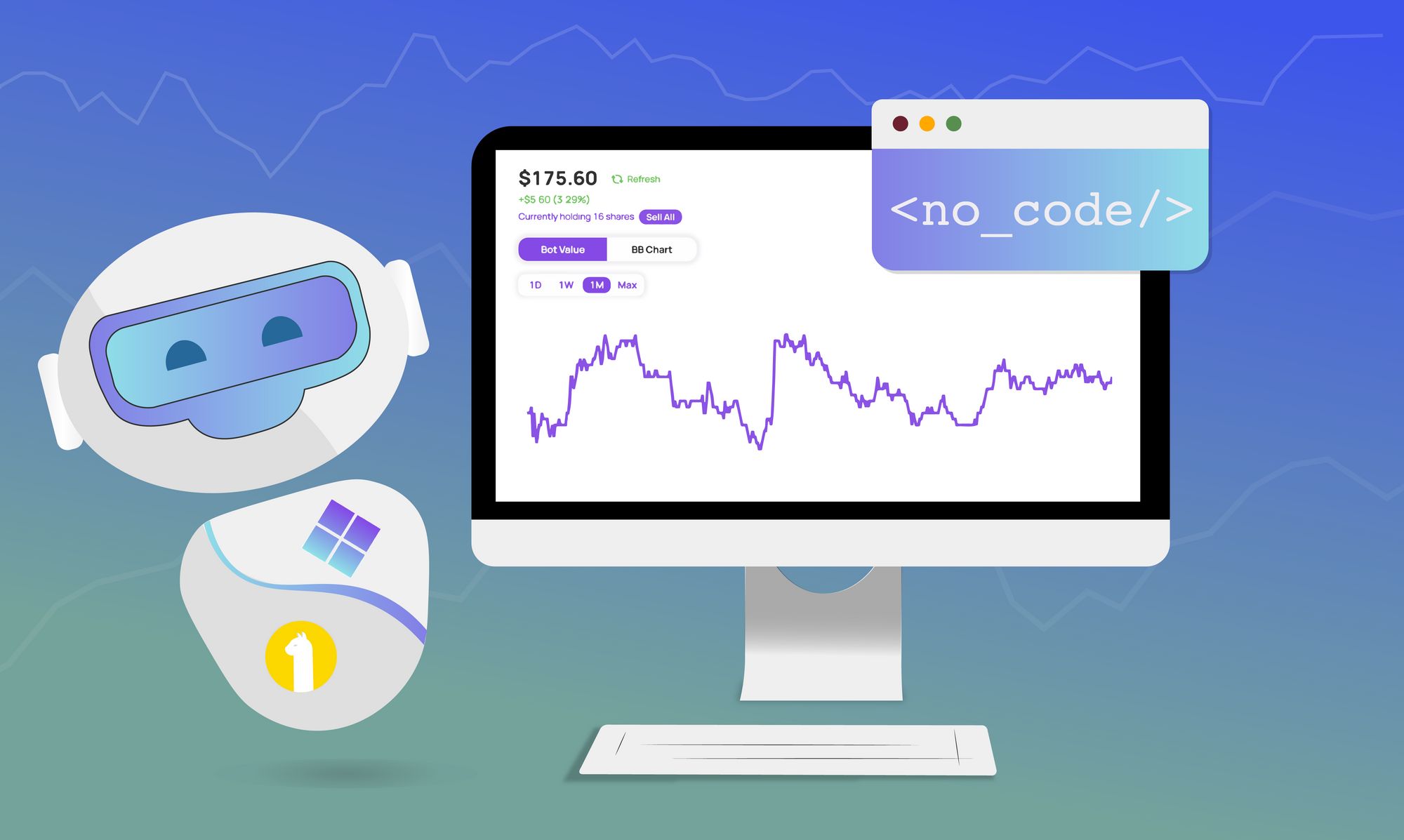Introduction
Welcome to the world of trading bots! In today’s fast-paced financial markets, having an automated trading system can give you a significant edge. Trading bots are computer programs that execute trades on behalf of traders based on predefined rules and algorithms. They have become increasingly popular among individuals and institutions alike due to their ability to execute trades with speed, accuracy, and consistency.
In this article, we will explore the process of building a trading bot from scratch. We will discuss the essential steps involved in creating an effective and profitable trading bot, covering everything from setting up a virtual environment to implementing sophisticated trading algorithms. By the end of this guide, you will have a solid foundation to develop your own automated trading system.
Before we dive into the technical details, it’s important to understand the underlying concepts of trading bots. These bots are designed to analyze market data, identify trading opportunities, and execute trades based on a set of predefined rules. They can be programmed to trade in various financial markets, including stocks, forex, cryptocurrencies, and commodities.
Building a trading bot requires a combination of technical skills, knowledge of financial markets, and programming expertise. It’s essential to have a good understanding of trading principles, risk management, and market analysis techniques. Additionally, proficiency in a programming language is crucial to implement the trading strategies and algorithms effectively.
Throughout this article, we will guide you through the process of building a trading bot step by step. We will explain the different components involved, the choice of programming language, and the integration with trading platforms. We will also discuss backtesting and optimizing the bot to ensure its effectiveness and profitability.
It’s important to note that building a trading bot is not a guaranteed path to instant riches. While trading bots can provide significant advantages, they are not immune to market risks and uncertainties. It’s imperative to exercise caution, conduct thorough research, and implement proper risk management strategies when using a trading bot.
So, if you’re ready to embark on the journey of building your very own trading bot, let’s get started! In the next section, we will discuss setting up a virtual environment to develop and test our trading bot.
Understanding Trading Bots
Before we jump into the technical aspects of building a trading bot, it’s essential to develop a solid understanding of what trading bots are and how they operate.
At its core, a trading bot is a computer program that executes trades automatically based on predefined rules and algorithms. It eliminates the need for manual trading and allows for faster execution, increased accuracy, and the ability to operate in multiple markets simultaneously.
Trading bots are designed to analyze market data and identify trading opportunities by scanning for specific patterns, indicators, or signals. These signals can be based on technical analysis, fundamental analysis, or a combination of both. The bot then executes trades based on these signals without human intervention.
One of the key advantages of using trading bots is their ability to remove emotions from the trading process. Emotions such as fear and greed can often cloud judgment and lead to poor decision-making. Trading bots operate purely based on logic and predefined rules, eliminating any emotional bias and ensuring consistent execution of trading strategies.
Trading bots can be categorized into two main types: trend-following bots and mean-reversion bots.
Trend-following bots aim to identify and take advantage of trends in the market. They buy assets that are trending upwards and sell assets that are trending downwards. These bots typically use indicators such as moving averages, trendlines, and price momentum to identify trends and generate trading signals.
Mean-reversion bots, on the other hand, operate under the assumption that prices of assets will eventually return to their mean or average value. These bots buy assets that are undervalued and sell assets that are overvalued. Mean-reversion bots often use indicators such as Bollinger Bands, RSI (Relative Strength Index), and MACD (Moving Average Convergence Divergence) to identify extreme price movements and generate trading signals.
It’s important to note that trading bots are not foolproof and do come with limitations. They rely on historical data and assumptions about future market conditions. Changes in market dynamics or unexpected events can sometimes lead to unsuccessful trades. Therefore, continuous monitoring, backtesting, and optimization of trading strategies are crucial to ensure the bot’s effectiveness and profitability.
In the next section, we will discuss the process of setting up a virtual environment to develop and test our trading bot. Creating a controlled environment is essential for avoiding risks and ensuring the smooth functioning of the bot. Let’s dive in!
Setting up a Virtual Environment
Setting up a virtual environment is an essential step in building a trading bot. A virtual environment provides a controlled and isolated environment where you can develop and test your trading bot without interfering with your system’s global configurations.
Here are the steps to set up a virtual environment:
1. Install Python: Python is a popular programming language for building trading bots. Make sure you have Python installed on your machine. You can download the latest version of Python from the official Python website and follow the installation instructions.
2. Install Virtualenv: Virtualenv is a tool that creates isolated Python environments. It allows you to install different versions of packages and libraries without conflicting with each other. Install Virtualenv by running the following command in your command prompt or terminal:
pip install virtualenv
3. Create a Virtual Environment: Once Virtualenv is installed, navigate to your project directory in the command prompt or terminal and create a new virtual environment. Run the following command to create the virtual environment:
virtualenv myenv
Replace “myenv” with the name of your virtual environment.
4. Activate the Virtual Environment: After creating the virtual environment, activate it by running the following command:
– For Windows:
myenv\Scripts\activate
– For MacOS/Linux:
source myenv/bin/activate
You will notice that the command prompt or terminal prompt changes, indicating that you are now working in the virtual environment.
5. Install Required Packages: With the virtual environment activated, you can now install the required packages and libraries for building your trading bot. Use the pip package manager to install the necessary dependencies. For example:
pip install pandas numpy matplotlib
These are just examples of some commonly used libraries. Depending on your specific requirements, you may need to install additional packages.
Setting up a virtual environment is crucial as it allows you to manage dependencies efficiently and keeps your system clean and organized. It also ensures that your trading bot is portable and can be easily deployed on different machines without compatibility issues.
In the next section, we will discuss choosing a programming language for building your trading bot. The choice of programming language depends on factors such as your familiarity, performance requirements, and the availability of relevant libraries and resources. Let’s explore the options!
Choosing a Programming Language
Choosing the right programming language is a critical decision when building a trading bot. The programming language you choose will determine the ease of development, availability of libraries and resources, and the performance of your bot. Here are some popular programming languages used for building trading bots:
1. Python: Python is one of the most popular programming languages for building trading bots. It is known for its simplicity, readability, and a vast collection of libraries and frameworks. Python offers excellent support for data analysis, which is essential for developing trading strategies. Some popular libraries for financial analysis and algorithmic trading in Python include pandas, numpy, and matplotlib. Python’s simplicity and the availability of ready-to-use libraries make it an excellent choice for beginners and experienced programmers alike.
2. Java: Java is a widely used language in the financial industry, making it a suitable choice for building trading bots. It provides a robust and secure development environment, and its scalability makes it suitable for large-scale trading operations. Java’s extensive ecosystem and mature tooling support enable developers to build highly efficient and performant trading bots. Additionally, Java’s object-oriented nature and emphasis on software engineering principles make it ideal for complex trading strategies.
3. C++: C++ is a high-performance language often used in the development of trading systems. It offers low-level programming control and efficient memory management, making it well-suited for latency-sensitive trading environments. C++ is known for its speed and ability to handle large volumes of data. However, building trading bots in C++ requires advanced programming skills and a deeper understanding of system-level programming concepts.
4. R: R is a language specifically designed for statistical computing and data analysis. It provides a wide range of statistical and econometric libraries, making it ideal for data-driven trading strategies. R’s built-in features for time series analysis, regression modeling, and machine learning make it a valuable tool for quantitative traders. However, compared to Python and Java, R may have a steeper learning curve and limited support for other non-trading related functionalities.
The choice of programming language ultimately depends on your personal preferences, experience, and the specific requirements of your trading bot. It’s important to consider factors such as library support, community resources, and the ability to integrate with trading platforms or APIs.
In the next section, we will discuss how to obtain market data, an essential component for building trading strategies. We will explore different sources of market data and discuss the considerations for selecting the most appropriate data for your trading bot.
Getting Market Data
Accurate and timely market data is crucial for building effective trading bots. It provides the necessary information to analyze market trends, identify trading opportunities, and make informed trading decisions. Here are some ways to obtain market data for your trading bot:
1. API Providers: Many financial data providers offer APIs (Application Programming Interfaces) that allow developers to access real-time and historical market data. These APIs provide access to a wide range of financial instruments, including stocks, forex, cryptocurrencies, and commodities. Some popular API providers include Alpha Vantage, Yahoo Finance API, and Binance API. These APIs typically require an API key, which you can obtain by signing up for the respective provider’s services.
2. Data Providers: There are also dedicated market data providers that specialize in offering historical and real-time market data. These providers gather and aggregate data from various sources and offer it in a standardized format. Examples of such providers include Bloomberg, Thomson Reuters, and Quandl. Note that these data providers often come with a subscription fee, which varies depending on the level of data access and the frequency of updates.
3. Web Scraping: If the desired market data is not readily available through APIs or data providers, web scraping can be an alternative solution. Web scraping involves extracting data from websites by automating the process of fetching HTML data and parsing it to extract relevant information. However, it’s crucial to respect the terms of service and any legal restrictions when scraping data from websites.
When obtaining market data, consider factors such as the frequency of updates, historical data availability, and the granular level of detail required for your trading strategies. It’s also important to ensure the quality and reliability of the data source, as inaccurate or delayed data can significantly impact the performance of your trading bot.
Once you have obtained the market data, you will need to clean and preprocess it to ensure its suitability for your trading strategies. This may involve data cleaning, handling missing values, adjusting for splits and dividends (in the case of stocks), and normalizing the data for analysis.
In the next section, we will delve into the process of developing a trading strategy, a crucial step in building a successful trading bot. We will discuss different types of trading strategies and the factors to consider when devising a strategy that aligns with your trading goals. Let’s dive in!
Developing a Trading Strategy
Developing a trading strategy is a critical step in building a successful trading bot. A trading strategy defines the set of rules and conditions that determine when to enter and exit trades. Here are some key considerations when developing a trading strategy:
1. Timeframe: Determine the timeframe over which your trading strategy will operate. Will it be a short-term strategy, focusing on intraday or swing trading, or a long-term strategy that holds positions for days, weeks, or even longer? The choice of timeframe will impact the types of indicators and signals you use to generate trade signals.
2. Technical Analysis: Technical analysis involves studying historical price trends, chart patterns, and indicators to identify potential entry and exit points. Common technical indicators include moving averages, MACD, RSI, and Bollinger Bands. Select indicators that align with your trading goals and use them to generate trading signals.
3. Fundamental Analysis: Fundamental analysis considers factors such as company financials, economic indicators, and market news to evaluate the intrinsic value of an asset. This approach is more commonly used in long-term investing, but it can also provide valuable insights for building trading strategies.
4. Risk Management: Proper risk management is essential for any trading strategy. Define your risk tolerance, determine the maximum percentage of capital you are willing to risk per trade, and set stop-loss and take-profit levels. Implementing risk management measures can help protect your capital and minimize losses during adverse market conditions.
5. Backtesting: Once you have defined your trading strategy, use historical data to backtest its performance. Backtesting involves running your strategy on past market data to see how it would have performed in real-world conditions. This allows you to assess the strategy’s profit potential, risk-reward ratio, and performance metrics. Make necessary adjustments based on the results of your backtesting.
6. Paper Trading: Before deploying your trading bot in live markets, consider paper trading or virtual trading. Paper trading involves simulated trading where you execute trades based on your strategy without using real money. This allows you to validate the performance of your bot in a risk-free environment before committing real capital.
Remember that developing a trading strategy is an iterative process. You may need to refine and adjust your strategy based on market conditions, feedback from backtesting, and real-time performance. Continuously monitor and evaluate the performance of your trading strategy to ensure its effectiveness and profitability.
In the next section, we will discuss the implementation of the trading algorithm, where we will bring our trading strategy to life. Stay tuned!
Implementing the Trading Algorithm
Now that you have developed a trading strategy, it’s time to implement the trading algorithm that will execute trades based on the strategy’s rules and conditions. Here are the key steps involved in implementing the trading algorithm:
1. Translate the Strategy into Code: Start by translating your trading strategy’s rules and conditions into code. Use the chosen programming language to write the necessary code that defines the entry and exit conditions, trade sizing, and risk management parameters. This code will serve as the backbone of your trading algorithm.
2. Connect to Market Data: Integrate your trading algorithm with the market data source you have chosen. This typically involves setting up a connection to the API or data provider and retrieving real-time or historical market data. Make sure you have access to the necessary data points required for your trading strategy.
3. Generate Trading Signals: Using the market data, apply the rules and conditions defined in your trading strategy to generate trading signals. For example, if your strategy relies on technical indicators, calculate the indicator values based on the market data and compare them against your predefined thresholds to trigger buy or sell signals.
4. Execute Trades: Once a trading signal is generated, the trading algorithm needs to execute the corresponding trade. This involves sending orders to a brokerage or trading platform through their API. The order should include details such as the asset, order type (market order, limit order, etc.), quantity, and any additional parameters required by the platform.
5. Implement Risk Management: Incorporate risk management measures into your trading algorithm. This may include setting stop-loss orders to limit potential losses, implementing position sizing algorithms to allocate the appropriate amount of capital for each trade, and managing portfolio diversification. Proper risk management is crucial to protect your capital and mitigate losses.
6. Error Handling and Logging: Develop error handling mechanisms to handle unforeseen issues or errors that may arise during the execution of the trading algorithm. Implement proper logging to record important events, errors, and trading activity. This will help with debugging and analyzing the performance of the trading algorithm.
7. Testing and Optimization: Test your trading algorithm thoroughly to ensure it is functioning as expected. Conduct rigorous testing using historical data and various market scenarios to validate its performance. Optimize the algorithm based on the results of the testing to fine-tune parameters, refine rules, and improve overall profitability.
Remember that implementing the trading algorithm is an iterative process. Continuously monitor and evaluate the performance of your algorithm and make necessary adjustments based on market conditions and real-time feedback.
In the next section, we will discuss integrating your trading algorithm with a trading platform or brokerage. This integration is crucial for executing trades in live markets. Let’s proceed to the next step!
Integrating with a Trading Platform
To execute trades in live markets, you need to integrate your trading algorithm with a trading platform or brokerage. This integration allows your trading bot to interact with the market, place orders, and manage positions. Here are the steps involved in integrating with a trading platform:
1. Choose a Trading Platform: Research and select a trading platform or brokerage that aligns with your trading requirements. Consider factors such as the availability of APIs, the range of tradable assets, transaction costs, and the platform’s reliability and security.
2. API Documentation: Familiarize yourself with the API documentation provided by the trading platform. The documentation will outline the API endpoints, authentication methods, order placement, order status retrieval, and other relevant information needed to interact with the platform programmatically.
3. Implement API Integration: Use the documentation and API libraries provided by the trading platform to integrate your trading algorithm with the platform. This involves sending requests to the platform’s API endpoints to place orders, retrieve market data, check account balance, and manage positions.
4. Authentication: Most trading platforms require authentication to ensure security and limit access to user accounts. Follow the authentication process specified by the platform’s API documentation to obtain and include the necessary authentication tokens or API keys in your requests.
5. Order Placement: When your trading algorithm generates a trading signal, you will use the trading platform’s API to place the corresponding order. The API will require details such as the asset, order type (market order, limit order, etc.), quantity, and any additional parameters needed for order execution.
6. Order Management: Once an order is placed, you will need to manage its lifecycle through the trading platform’s API. This includes tracking the order status, canceling orders if necessary, and retrieving fills or executions when the order is completed.
7. Error Handling and Logging: Implement proper error handling mechanisms to handle any potential errors or exceptions that may occur during the API integration process. Additionally, implement logging to record important events, errors, and trading activity for future analysis and debugging.
8. Testing and Simulation: Before deploying your trading bot with live funds, thoroughly test the integration with the trading platform in a simulated or paper trading environment. This will help identify any issues or discrepancies between the algorithm’s behavior and the actual execution on the platform.
Integration with a trading platform allows your trading bot to operate in real-time markets, execute trades, and manage positions automatically. It’s essential to ensure the integration is robust, reliable, and continuously monitored to maintain the smooth functioning of your trading bot.
In the next section, we will discuss the importance of backtesting and optimizing your trading bot to enhance its performance and profitability. Stay tuned for more!
Backtesting and Optimizing the Bot
Backtesting and optimizing your trading bot is a crucial step in ensuring its effectiveness and profitability. Backtesting involves testing your trading algorithm on historical market data to evaluate its performance and validate its potential profitability. Here are the steps to backtest and optimize your bot:
1. Historical Data Selection: Choose a suitable dataset for backtesting your trading bot. The dataset should cover a significant period and include relevant market data such as price, volume, and other indicators required by your trading strategy.
2. Define Backtesting Parameters: Determine the timeframe, starting capital, and any other relevant parameters for the backtesting process. Set realistic transaction costs and slippage values to simulate real-world trading conditions accurately.
3. Implement the Backtesting Engine: Develop or use a backtesting framework or library that allows you to replay the historical market data and simulate order placement and execution based on your trading algorithm. The backtesting engine should provide performance metrics, such as returns, drawdowns, and win rates.
4. Run the Backtest: Run the backtest by feeding the historical data into the backtesting engine and applying your trading algorithm’s logic to generate buy and sell signals. The backtesting engine will simulate the execution of these signals and track the performance of your trading strategy over the specified historical period.
5. Evaluate Performance: Analyze the performance metrics generated from the backtest to evaluate the effectiveness of your trading bot. Assess metrics such as overall returns, maximum drawdown, risk-reward ratio, and win rate. Identify areas for improvement and potential issues, such as overfitting or sensitivity to specific market conditions.
6. Optimize and Refine: Based on the performance evaluation, optimize and refine your trading strategy. This may involve adjusting the parameters of your algorithm, incorporating additional indicators, or fine-tuning risk management rules. Iteratively refine and retest your strategy until you achieve satisfactory performance and risk/reward characteristics.
7. Walk-Forward Testing: To validate the robustness of your optimized trading strategy, perform walk-forward testing. This involves dividing your historical data into in-sample and out-of-sample periods. Optimize your strategy using the in-sample data, and then test it on the out-of-sample data to assess its performance in unseen market conditions.
8. Continuous Optimization: Once your trading bot is live, monitor its performance and conduct periodic reviews and optimizations. Markets are dynamic, and what works well in one period may need adjustments to perform optimally in different market conditions. Stay vigilant and adapt your strategy as needed to optimize its ongoing performance.
Backtesting and optimizing your trading bot provide valuable insights into its performance and the potential risks and rewards associated with using it in live markets. Regularly revisit and refine your bot’s strategy to ensure its effectiveness and profitability over the long term.
In the next section, we will discuss implementing risk management techniques within your trading bot to protect your capital and manage potential losses. Stay tuned!
Implementing Risk Management
Implementing effective risk management techniques is essential for protecting your capital and managing potential losses when using a trading bot. Here are some key risk management practices to consider when implementing risk management in your trading bot:
1. Determine Risk Tolerance: Assess and define your risk tolerance level. This involves understanding how much of your trading capital you are willing to risk per trade or per day. Establishing risk thresholds will help you avoid excessive losses and ensure consistent risk management.
2. Position Sizing: Implement a position sizing algorithm that determines the appropriate trade size based on your risk tolerance and the specific trade’s characteristics. This algorithm ensures that each trade’s size aligns with your overall risk management strategy. Common position sizing techniques include fixed dollar amount, percentage risk per trade, or volatility-based sizing.
3. Stop-Loss Orders: Include stop-loss orders in your trading algorithm to limit potential losses. A stop-loss order is a predetermined price level at which your trade will be automatically exited to cut losses. Set the stop-loss level based on your risk tolerance and analysis of the asset’s price dynamics.
4. Take-Profit Levels: Set take-profit levels in your trading algorithm to secure profits when the trade goes in your favor. A take-profit level is a predetermined price level at which your trade will be automatically closed to lock in profits. Determine the take-profit level based on your trading strategy and assessment of the asset’s price potential.
5. Diversification: Implement diversification techniques to spread your risk across different assets or markets. Diversifying your trades can help reduce the impact of a single trade’s outcome on your overall portfolio performance. Consider including different types of assets, such as stocks, forex, cryptocurrencies, or commodities, in your trading strategy.
6. Risk-Reward Ratio: Define a risk-reward ratio for each trade to assess the potential profitability against the potential loss. A favorable risk-reward ratio indicates that the potential reward outweighs the potential risk, making the trade more attractive. Aim for a risk-reward ratio that aligns with your trading strategy and risk tolerance.
7. Regular Monitoring: Continuously monitor the performance of your trading bot and its risk management parameters. Regularly assess the efficiency of your risk management techniques and make adjustments if necessary. Markets change, and what worked in one period may need modifications to adapt to changing conditions.
8. Backtesting Risk Management: Perform backtests specifically focused on evaluating the effectiveness of your risk management techniques. Assess metrics such as maximum drawdown, risk-adjusted returns, and the overall stability of your portfolio. This will help you fine-tune your risk management strategy and optimize your trading bot’s performance.
Remember, risk management is crucial for preserving capital and long-term success. Effective risk management not only protects you from potential losses but also ensures you can continue executing your trading strategy with confidence.
In the next section, we will explore the process of running your trading bot in live markets and discuss the importance of continuous monitoring and tweaking. Let’s move forward!
Running the Trading Bot in Live Markets
Running your trading bot in live markets is an exciting phase as it brings your automation efforts to life. Here are some key considerations when running your trading bot in live markets:
1. Start with Small Positions: As you transition from backtesting and paper trading to live trading, it’s wise to start with small positions. This allows you to gauge the performance of your trading bot in real market conditions and gradually increase position sizes as you gain confidence and observe consistent profitability.
2. Monitor Execution and Order Fills: Keep a close eye on the execution of trades and order fills when your bot is active in live markets. Ensure that the prices executed are close to your expected prices and that there are no delays or connectivity issues with the trading platform or broker. Make necessary adjustments if you encounter any execution discrepancies.
3. Monitor Performance Metrics: Continuously monitor the performance metrics of your trading bot, such as overall returns, win rate, and risk-reward ratio. Regularly assess its performance against your expectations and benchmarks. If the trading bot is not meeting your goals, consider making adjustments to the strategy, risk management rules, or other parameters.
4. Track Market Conditions: Keep an eye on market conditions and any relevant news or events that may impact the performance of your trading bot. Stay informed of market trends, volatility, and economic indicators that could influence your trading strategy. Make necessary adaptations to your bot’s rules or risk management techniques to align with changing market dynamics.
5. Continuous Monitoring and Tweaking: Trading is dynamic, and the performance of your trading bot may need continuous monitoring and tweaking. Review and analyze trade logs, performance metrics, and execution details regularly. Identify any areas for improvement or potential issues and make proactive changes to optimize your trading bot’s performance.
6. Risk Control and Management: Stick to your risk management plan and ensure that your trading bot adheres to the predefined risk parameters. Regularly review and reassess your risk tolerance and adjust your position sizes and stop-loss levels accordingly. Implement checks and alarms to monitor risk levels and take action if they exceed your predefined thresholds.
7. Avoid Over-Optimization: Be cautious of over-optimizing your trading bot based on past market data. Market conditions may change, and overly optimizing your strategy to fit historical data perfectly can lead to poor performance in real-time markets. Instead, focus on robust strategies that have been validated through extensive testing and consider adapting your bot to changing market conditions.
8. Keep Emotions in Check: Even with a fully automated trading bot, emotions can still come into play. Avoid the temptation to intervene or make impulsive decisions based on short-term market fluctuations. Stick to your predefined strategy and trust in the system you have built.
Running your trading bot in live markets requires vigilance, discipline, and continuous monitoring. Regularly assess its performance, make necessary adjustments, and maintain a disciplined approach to risk management. With proper supervision and refinement, your trading bot has the potential to generate consistent profits and enhance your trading activities.
In the next section, we will discuss the importance of monitoring and tweaking your trading bot to ensure its ongoing effectiveness. Let’s explore further!
Monitoring and Tweaking the Bot
Monitoring and tweaking your trading bot is a crucial aspect of maintaining its effectiveness and optimizing its performance. Here are some key steps to monitor and tweak your trading bot:
1. Continuous Performance Monitoring: Regularly monitor the performance of your trading bot in live markets. Keep track of important metrics such as overall profitability, win rate, risk-reward ratio, and drawdowns. Analyze these metrics over different time periods to assess the bot’s consistency and adaptability to varying market conditions.
2. Analyze Trade Logs: Review the trade logs of your trading bot to gain insights into its execution and decision-making process. Analyze both winning and losing trades to identify patterns, strengths, and areas for improvement. Look for any potential errors or anomalies that may need attention and make necessary adjustments.
3. Identify Market Changes: Keep a close eye on market conditions and identify any shifts or changes that may impact your trading bot’s performance. Monitor factors such as volatility, market trends, news events, and economic indicators that may influence your trading strategy. Adjust your bot’s parameters or rules if necessary to adapt to changing market dynamics.
4. Backtesting and Optimization: Regularly perform backtesting and optimization exercises to refine your trading bot’s strategy and parameters. Use new datasets and market conditions to evaluate its performance and identify any weaknesses or potential improvements. Optimize your bot based on the findings to enhance its profitability and risk mitigation capabilities.
5. Analyze Risk Management: Continuously assess the effectiveness of the risk management techniques implemented in your bot. Ensure that position sizing, stop-loss levels, and risk-reward ratios align with your risk tolerance and trading goals. Adjust these parameters if needed based on your ongoing risk assessment and any changes in market conditions.
6. Consider Market Dynamics: Keep abreast of changing market dynamics and adapt your trading bot accordingly. Different market environments (e.g., trending, ranging, or volatile markets) may require different strategies or additional filters in your bot’s decision-making process. Review and tweak your trading rules to ensure they align with the prevailing market conditions.
7. Evaluate Impact of External Factors: Consider external factors that may impact the performance of your trading bot. This could include changes in regulations, shifts in investor sentiment, trading platform updates, or disruptions in data sources. Stay informed about these factors and adjust your bot’s operations accordingly to mitigate any potential risks.
8. Regular Testing and Simulation: Perform regular testing and simulation exercises to evaluate your trading bot’s performance under different scenarios. Simulate various market conditions, liquidity conditions, and trading volumes to ensure your bot can handle different scenarios effectively. This helps validate the robustness and adaptability of your bot.
9. Seek Professional Input: Engage with experienced traders or consultants who can provide valuable insights and guidance on monitoring and tweaking your trading bot. Their expertise and experience can help identify blind spots, suggest improvements, and offer alternative perspectives.
By regularly monitoring and tweaking your trading bot, you can ensure that it remains adaptive, effective, and aligned with your trading goals. Remember, markets are dynamic, and continuous evaluation and refinement is key to maintaining a successful trading bot.
In the final section, we will wrap up our discussion and summarize the key takeaways from the process of building and running a trading bot. Let’s conclude our journey!
Conclusion
Building and running a trading bot is a complex yet rewarding endeavor that can provide a competitive edge in today’s financial markets. Throughout this guide, we have explored the essential steps involved in creating an automated trading system.
We began by understanding the concept of trading bots and their benefits, including speed, accuracy, and emotion-free trading. We then discussed setting up a virtual environment and selecting a programming language that suits your needs.
Obtaining reliable market data, developing a robust trading strategy, and implementing risk management techniques were highlighted as crucial components of building a successful trading bot. We emphasized the importance of backtesting and optimizing your bot to ensure its effectiveness and profitability.
Integrating your trading algorithm with a trading platform or brokerage allows for seamless execution of trades in live markets. We also emphasized the significance of continuous monitoring and tweaking to adapt to changing market conditions and improve performance over time.
Remember, running a trading bot in live markets requires discipline, risk management, and ongoing evaluation. Regularly monitor performance, analyze trade logs, and be vigilant about market dynamics. Continuously test and optimize your trading bot to ensure its adaptability and long-term profitability.
Building and running a trading bot is a journey that requires continuous learning and improvement. Stay updated with market trends, seek professional advice when needed, and be prepared to adapt your strategies as the market evolves.
With effective implementation and diligent monitoring, a well-designed trading bot can provide a valuable tool for executing your trading strategies, reducing emotional bias, and enhancing your overall trading experience.
So, if you’re ready to step into the world of automated trading, embrace the challenges, and unlock the potential of trading bots. May your journey be filled with profitable trades and insightful learnings.
Happy trading!

























